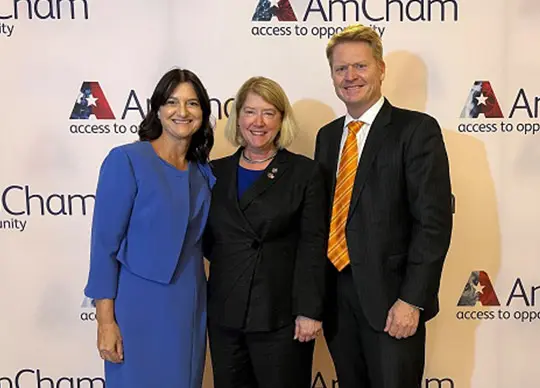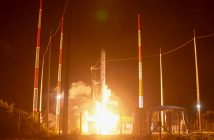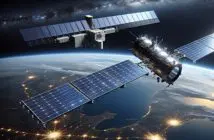
Written by Tim Larcombe, AROSE.
For the more than 300 guests who attended the American Chamber of Commerce business luncheon in Perth, the event exceeded their expectations as Col. Melroy shared insights from a life at the forefront of aeronautics, Space flight and NASA’s Artemis program.
Col. Melroy has one of the most impressive resumes on the global stage. As a former US Air Force aircraft commander, Col. Melroy logged more than 6,000 flight hours in 50 different aircraft, including 200 combat and combat support hours. She is a veteran of Operation Desert Storm for the liberation of Kuwait in 1991.
NASA selected Col. Melroy as a candidate astronaut in 1994. She went on to log 924 hours in Space. She served as a pilot on two Space Shuttle flights and was mission commander in 2007, one of only two women to command a Space Shuttle.
After serving more than two decades in the US Air Force and as a NASA astronaut, Col. Melroy held leadership roles at Lockheed Martin, Federal Aviation Administration, Nova Systems, and as an advisor to the Australian Space Agency.
Col. Melroy’s presentation at the Amcham event emphasised the unique and critical role Australia plays in the global Space sector, and the importance of Australia to NASA’s return to the Moon and on to Mars.
Australia gets new LEGS
Col. Melroy confirmed NASA would locate one of three new lunar exploration ground sites, or LEGS, in Australia.
At a site yet to be announced, Australia’s LEGS ground station will be critical to the success of the Artemis program, providing enhanced direct-to-Earth communications capabilities to lunar missions.
“Australia is in a unique location and not just for ground communications,” Col. Melroy said. “Australia provides us global coverage and helps us understand the atmosphere of the Earth and that upper region of this part of the world.”
She said Western Australia’s location, clear skies and low moisture levels are particularly important for certain types of communications, notably new laser communications to-and-from Space.
She also highlighted Western Australia’s capability in robotics, automation and extraction technologies “which we’re going to need in the future on the Moon and Mars and out into the solar system”.
“No other country owns this space, or could even possibly catch up,” Col. Melroy said. “WA has all those technologies and they’re going to be critical to the future of Space exploration.”
Col. Melroy said the success of the Artemis 1 mission means NASA expects the first mission to send humans back to the moon would happen in “a little less than two years”. That mission will recreate the 1968 Apollo 8 mission and send a human crew around the moon.
Apollo 8 was the first crewed spacecraft to leave low Earth orbit and the first human space flight to reach the Moon. Apollo 8 orbited the Moon 10 times, before returning safely to Earth.
Seed corn of humanity
Speaking more broadly on the importance of science and Space exploration, Col. Melroy said science is the “seed corn of humanity”.
“The scientific research we do today leads to the insights that create the technologies and capabilities of the future,” Col. Melroy said. “There’s no better way to study the climate of the Earth and the changing of the Earth’s atmosphere – from bedrock and water all the way up to the atmosphere – than from Space, because it’s where we get the global picture.”
The other important driver for Space exploration is to “increase national posture”.
“When we do really hard things – and going to Space is hard make no mistake – we actually live the capability of the country in science and technology.
“That has spill-over effects. We spin out into other capabilities, which can be transformational and solve other problems that the country has.”
Col. Melroy said Fugro’s new remote operations centre in Perth, SpAARC, is a great example of how infrastructure can support multiple, multi-user activities which raise the capabilities of industry, academia and the country as a whole.
In addition, with the growing commercial Space industry, the economic benefits of a high growth, high tech industry cannot be understated.
“In the future I believe Space will provide persistent global communications and data that will affect every industry.”
Inspiring the Artemis Generation
Space exploration also inspires the next generation to dream big and seek careers in Space.
As a member of the “Apollo Generation”, Col. Melroy said she was among the group of students inspired by the first moon landing.
She said the “Artemis Generation” would give rise to greater opportunities for women and people of colour on a “more inclusive step-out into the solar system”.
“The first person to walk on Mars is somewhere in a classroom today,” Col. Melroy said.
“We’re here to create the future, the future of humanity in the solar system.”





